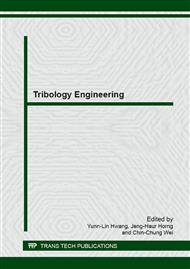p.242
p.248
p.253
p.259
p.264
p.270
p.275
p.281
p.286
Tribological Study of PCL-PEG-PCL Polymer on SiNxHy Base
Abstract:
Tribological behaviour of polymer and hard coating films is complicated with bio-lubricant. Contacting and kinematic conditions of a knee joint when a person in running was simulated in the study. Substrates of specimens are Ti6Al4V and 316LVM stainless steel. Two kinds of polymer films, PCL-PEG-PCL and mPEG-PCL-mPEG, were used to simulate the tissue of cartilage. The silicon nitride film, SiNxHy prepared by PECVD, was used as a protecting film, and it’s thickness about 1000 nm under the polymer film. The testing device was developed, upper specimen is rotated reversely and the lower one is moved linearly forward and backward for 6 mm. A frequency vibration is applied under the lower specimen to simulate the vibration caused from walking, which is sated 2 Hz. Two torque meters are used for friction measurement in rotational and sliding directions. Experiments simulated vertical vibration, rotary and reciprocating motion. Comparing friction coefficient with different substrates with SiNxHy film, mixture of PCL-PEG-PCL and bovine serum can effectively decrease friction but useless for mPEG-PCL-mPEG. If adhesion of PCL-PEG-PCL polymer can be improved, it has potential in the application of artificial joint.
Info:
Periodical:
Pages:
264-269
Citation:
Online since:
April 2015
Authors:
Keywords:
Price:
Сopyright:
© 2015 Trans Tech Publications Ltd. All Rights Reserved
Share:
Citation:


